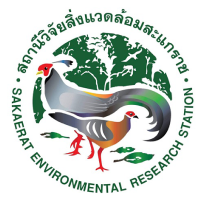Keywords :
Macaca leonina; Degraded Forest Environment
บทคัดย่อ :
We studied these patterns for eleven months in regard of fruit availability in a wild troop of these macaques. Weused Characteristic Hull Polygons (CHP) combined with spatial statistics to estimate home ranges and core areas. We ran amonthly phenology survey to measure fruit availability over the study period. We predicted that macaques would increasetheir ranging during low fruit abundance to gather enough food (i.e. energy-maximizing strategy) and would use moreintensively plantation and edge areas. We found a total home range of 535.5 ha and an average core area of 219.3 ha, withan average daily path length of 2,226 m. During high fruit abundance, macaques spent more time around fruit-tree speciesin the dry evergreen forest. During low fruit abundance, they extended their home range to plantations forest and edgeareas. Fruit consumption was positively correlated to fruit abundance and there was a clear shift from flesh and pulp to dryfruit during low fruit abundance season. While the portion of home range used decreased in period of high fruit availability,daily path length and core area size did not change. Overall, as predicted, our preliminary data shows that the study troopused an energy-maximizing strategy and was able to expand the range of resources consumed in fruit scarcity period
เอกสารอ้างอิง :
Gazagne, E., Hambuckers, A., Savini, T., & Huynen, M. C. (2018). Surviving in a degraded forest environment: foraging strategies and space use of northern pigtailed macaques (Macaca leonina) in Sakaerat Biosphere reserve, Northeastern Thailand.



